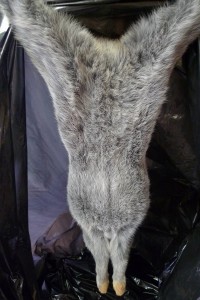When we’re young we have lots of ‘firsts’. As we get older we have fewer and fewer; both because of life experiences and because we tend to specialize and stay within our comfort zones. Yesterday I had a first, I learned how to butcher rabbits. Now I realize that butchering most small animals is about the same, but I had never killed and/or butchered anything before. That includes hunting; though I’ve nothing against hunting–and plan to learn–I didn’t grow up hunting and have never gone as an adult.
 I went to Rob and Beckie’s home–they provided our does–and Rob taught me how to butcher rabbits. The siblings of the rabbits I got from him had matured (three months). He did the first one as I watched, I did the second one and he walked me through the process. We then finished the rest, each working on his own, but Rob was always available to help or answer my questions.
I went to Rob and Beckie’s home–they provided our does–and Rob taught me how to butcher rabbits. The siblings of the rabbits I got from him had matured (three months). He did the first one as I watched, I did the second one and he walked me through the process. We then finished the rest, each working on his own, but Rob was always available to help or answer my questions.
As I reflected on how I felt about butchering the rabbits, both at the time and afterward, I think the best word I could come up with was ‘satisfaction.’ Satisfaction that we had done it respectfully and efficiently, that the rabbits had not suffered, and that the meat would be used to feed our families and improve our diets. Before we killed each one we calmed it, thanked it for it’s sacrifice, and promised to appreciate what it would provide.
I’m glad I’ve learned. I can’t say I look forward to the next time, but I feel confident that I can do it well, painlessly, and without waste. I like knowing that I can provide a healthy source of protein for my family. Both Rob and I would like to learn how to tan the hides and utilize the pelts.
I felt a bit overwhelmed when we first got our rabbits, but it’s much easier than I thought it would be. I enjoy the day-to-day chores of raising and feeding them; soon we will go through the process of breeding and bringing up the next litter, and I know now how to harvest the meat that we will raise. I encourage anyone who is considering raising rabbits that it’s a good idea, it’s easier than you think, and it will be a valuable addition to your homestead, big or small. Any help I can give you, either in the form of rabbits to raise as your own, skills I can teach you, or knowledge that I’ve learned I’d be happy to.
I’ve mentioned it before but I’d strongly recommend RiseandShineRabbitry.com and Storey’s Guide to Raising Rabbits. Both are excellent sources of advice and how-to information on raising rabbits.
An interesting side-note: When we first got our “does” from Rob (at six weeks), we instead got one female and one male (it’s harder to tell than you think). When we discovered this, Rob told me to just bring the male when I came and we’d swap it out for a healthy female.
Rob knew that I pastured my rabbits as much as possible (maybe half their diet), and he feeds his strictly store-bought rabbit feed, so he suggested an experiment: once butchered we’d compare my male and how much fat he had and how much the meat weighed to the ones Rob had raised. We found that my pasture fed rabbit had considerably less fat, but the meat weighed almost the exact same.


